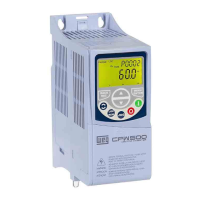
Do you have a question about the WEG CFW500 V1.8X and is the answer not in the manual?
| Category | DC Drives |
|---|---|
| Model | CFW500 V1.8X |
| Protection degree | IP20 |
| Overload capacity | 150% for 60s |
| Braking | Dynamic braking |
| Communication | Modbus RTU |
| Control Mode | Sensorless Vector |
| Protection Features | Overcurrent, Overvoltage, Undervoltage, Overtemperature, Short circuit |
| Communication Interface | RS485 |
| Operating Temperature | -10 to 50 °C (14 to 122 °F) |
| Storage Temperature | -20°C to +65°C |
| Humidity | 5 to 95% non-condensing |
| Switching frequency | 4-16 kHz |
Manual safety warnings for user protection against death, injury, or damage.
Safety symbols fixed to the product indicating high voltage, ESD, earth connection, and hot surface.
Recommendations for qualified personnel regarding installation, operation, and safety precautions.
Information about the manual's purpose and scope.
Definitions of terms and symbols used in the manual for clarity.
Guide to using the Human-Machine Interface (HMI) for operating and parameterizing the inverter.
Explanation of the information fields displayed on the HMI LCD display.
Description of the HMI's monitoring and setting modes, including navigation levels.
Overview of how CFW500 parameters are classified into ten groups for easier access.
Explanation of how to select parameter groups via the HMI menu for parameter browsing.
Details on HMI-related parameters like display, backlight, and password settings.
Explains the CONFIG status and its causes, indicating incorrect or incomplete inverter configuration.
Parameters related to inverter software versions and plug-in module configuration.
Defines how to select command and reference sources for Local and Remote situations using parameters.
Details how speed reference is processed, its scale, and modification based on source.
Explains the inverter control word and status word for exchanging information with external modules.
Details on adjusting the V/f curve using five different points for optimal motor control.
Step-by-step guide for installing, powering up, and starting up the inverter in V/f mode.
Steps to configure VVW vector control using motor nameplate data and HMI startup menu.
Procedure for installing, powering up, and performing the startup sequence for VVW mode.
Explanation of inverter ramp functions for controlling motor acceleration and deceleration.
Describes protection functions that limit DC link voltage and output current to prevent faults.
Explains functions for driving a spinning motor or recovering the inverter during power supply drops.
Method for stopping the motor by applying direct current, controlled by braking torque.
Configuration of analog inputs for external speed reference or sensor connection.
How a digital input converts pulses into a proportional signal for speed reference or other uses.
Parameter descriptions for configuring the function of up to eight digital input ports.
Configuration parameters for digital output functions (DO1 to DO5).
Explains the PID controller function for closed-loop process control and defines key terms.
Step-by-step guide for enabling and configuring the PID controller for proper operation.
Detailed description of parameters related to PID controller configuration, including gains and scales.
Protection against motor overload and overtemperature using Ixt and PTC sensors.
Protection for IGBTs and power modules against overload and overheating.
Fast hardware protection against output overcurrent, ground faults, and DC link voltage issues.
Faults related to software version incompatibility and communication errors.
Function to automatically reset a fault based on a time setting, with limitations.
Details on serial interfaces for communication, depending on the plug-in module.
Configuration and operation parameters for CANopen and DeviceNet interfaces.
Parameters for configuration and operation of the Profibus DP interface.
Parameters for configuration and operation of the Ethernet interface.